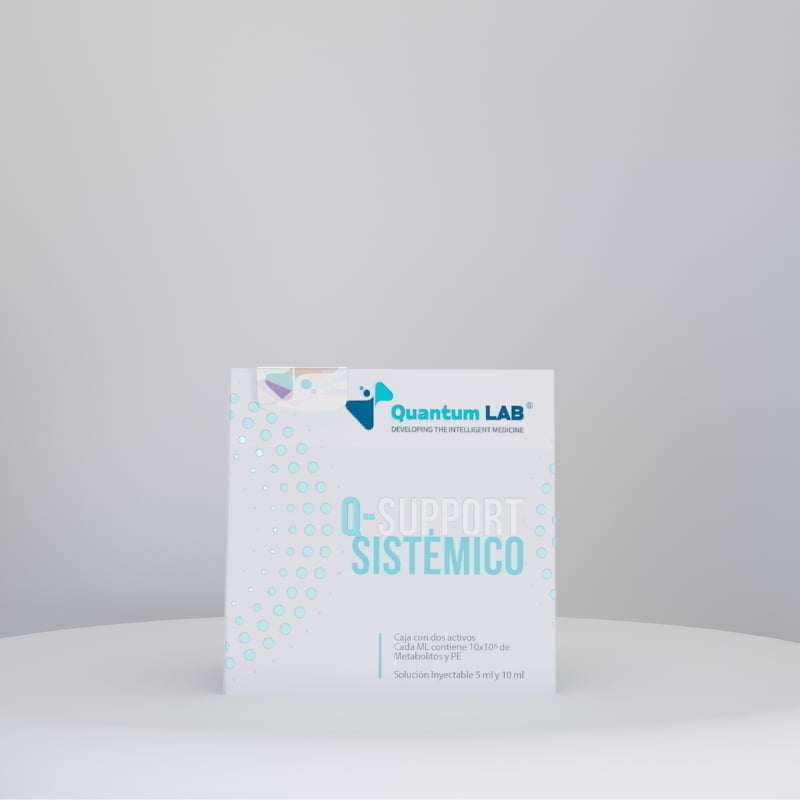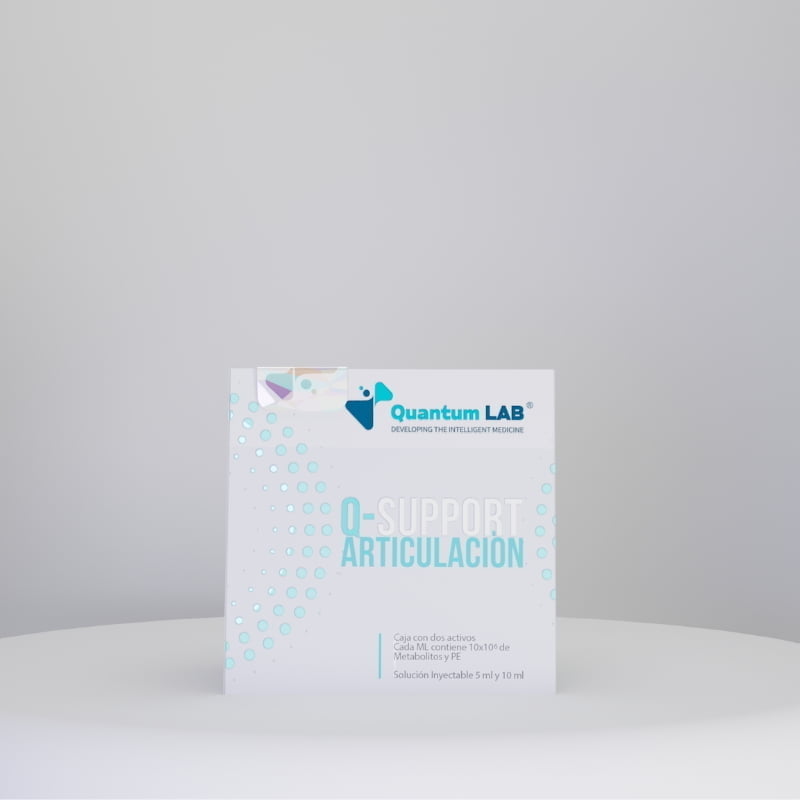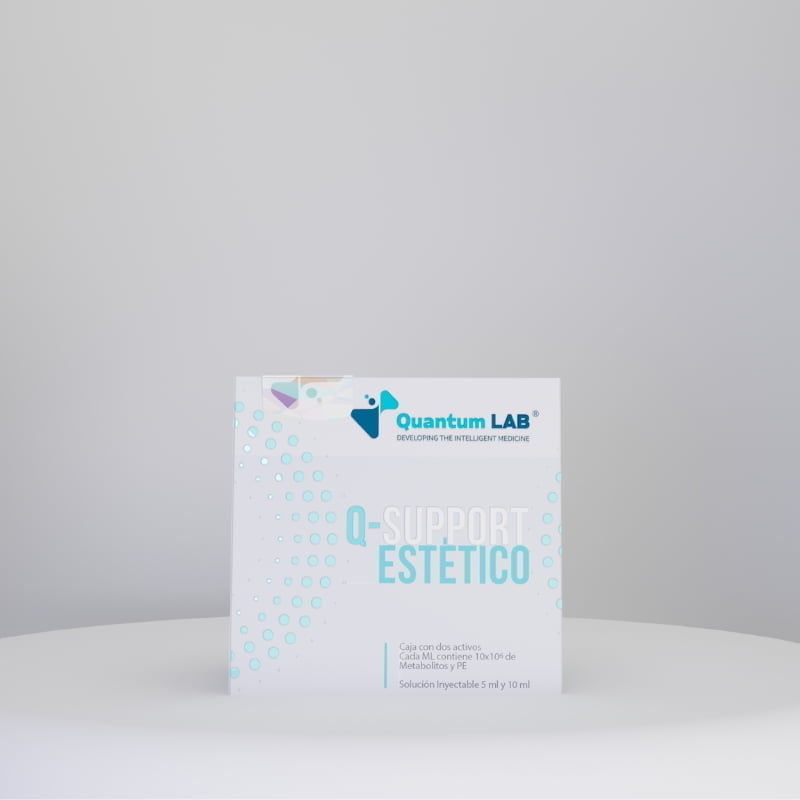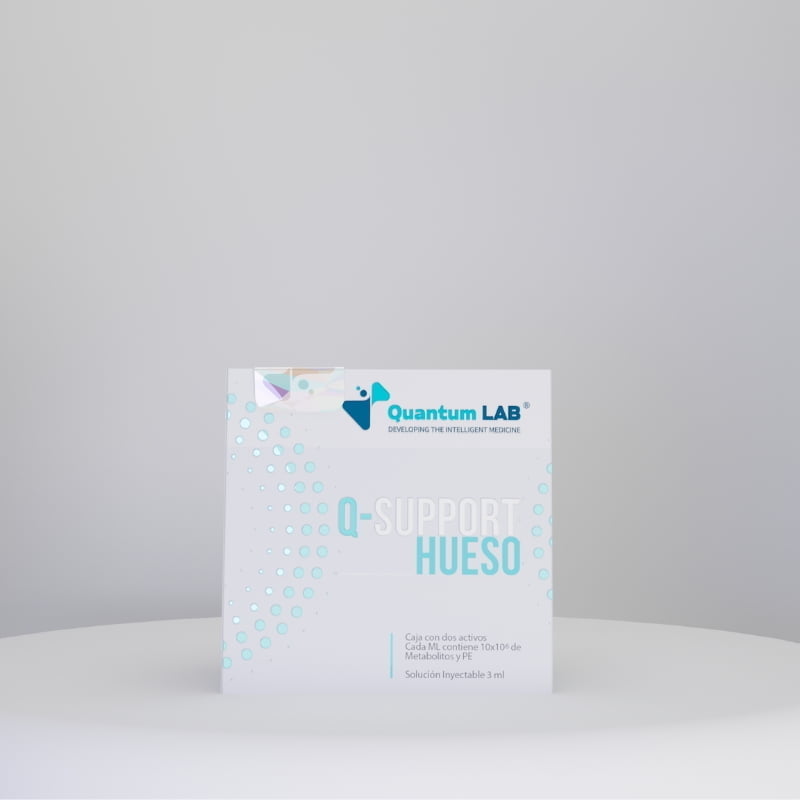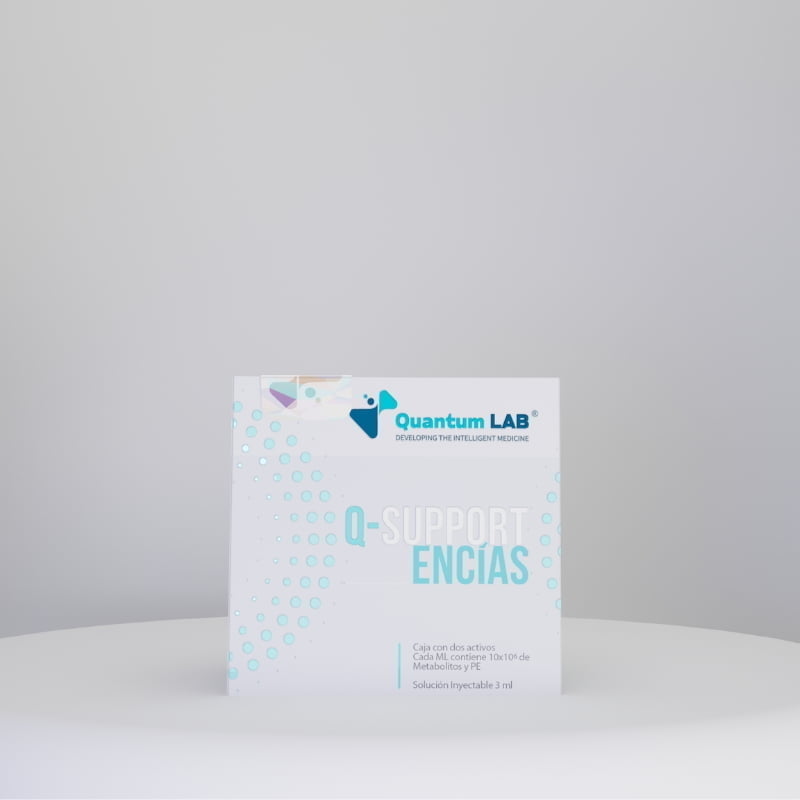At Quantum Lab, we pride ourselves on being pioneers in the development of advanced regenerative medicine solutions, specifically designed for healthcare professionals. Our exclusive Q-Support line offers a range of stromal precursor (mesenchymal stem cell) and exosome products, each created to meet the unique needs of different medical specialties.
Q-Support Product Line
Medical Training
We offer medical training on the proper use of our products, taught by specialists with years of experience. This training allows you to make the most of our products, providing your patients with optimal and advanced treatment.
Viability Guarantee
We take pride in offering high viability in each of our products, giving you the peace of mind that our products will maintain their effectiveness and provide the best possible treatment for your patients, regardless of the time elapsed.
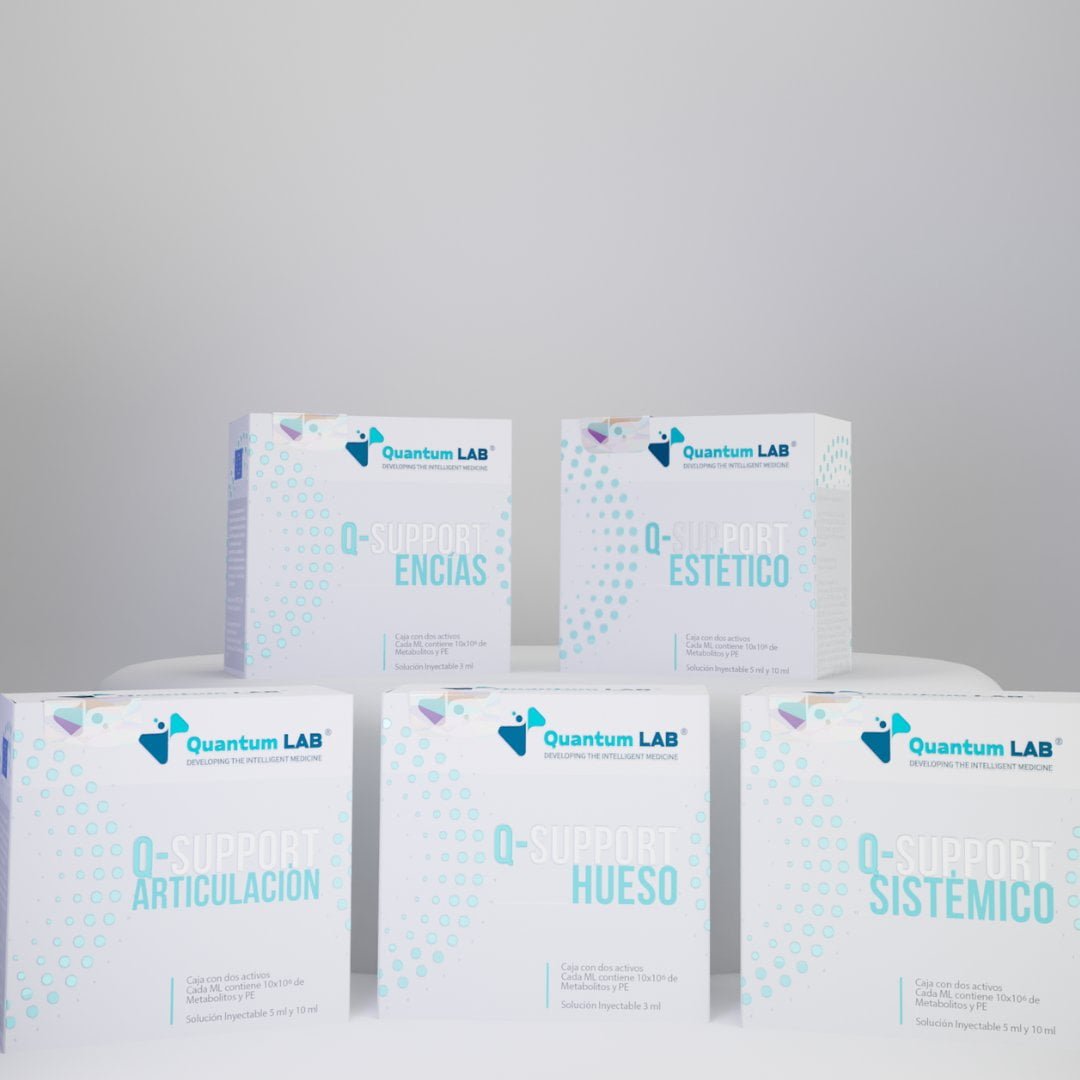
Specific Solutions
Each product in the Q-support line has been carefully designed to provide specific solutions in the field of cellular regeneration. Our products can meet the needs of any cellular regeneration treatment that requires a personalized and advanced approach.
Complete Kit
Each presentation of our products includes two vials, one with stromal precursors and supplements, and another vial with activator cofactors and stromal metabolites equivalent to the requisition of the first vial.
TROMAL PRECURSOR Products & Applications
Q-SUPPORT SYSTEMIC
Q-SUPPORT JOINT
Q-SUPPORT AESTHETIC
Q-SUPPORT BONE
Q-SUPPORT GUMS
Ideal for general practitioners and specialists in chronic degenerative and autoimmune diseases. Q-Support Systemic addresses these conditions in an innovative way, improving the overall quality of life of the patient. This product helps control inflammation and activates the regeneration process in the body, being a comprehensive solution for those facing complex and multifaceted diseases.
Developed for rheumatologists, orthopedists, and sports medicine physicians, Q-Support Joint is an advanced solution for joint disorders. This product facilitates the regeneration of cartilage and relieves pain and inflammation associated with joint conditions. It is an essential tool for improving mobility and quality of life in patients with joint problems.
For dermatologists and specialists in aesthetic medicine, Q-Support Aesthetic is at the forefront of skin rejuvenation and care. This product revitalizes the production of elastin and collagen, improves the appearance of scars and stretch marks, and aids in hair health and muscle definition. Q-Support Aesthetic is ideal for patients seeking effective and natural anti-aging treatments.
Specially created for dentists and dental implantologists, Q-Support Bone focuses on bone regeneration. This product is key for those seeking to improve the integration of dental implants and the reconstruction of bone tissue. Its ability to stimulate cellular regeneration and enhance bone density makes Q-Support Bone an indispensable tool in modern implantology.
Designed for dentists and dental implantologists, Q-Support Gums is a revolutionary solution for periodontal health challenges. This product offers an effective way to combat gum recession and inflammation, facilitating the regeneration of gum tissue. It is ideal for patients with gum diseases, providing a non-invasive method to improve their oral health and quality of life.
WHAT ARE stromal precursors?
They are cells with the ability to repair damaged tissues or organs, given their high capacity to differentiate into different cell lines capable of repairing injuries to the skin, bone, tendons/joints, muscle, heart, kidney, lung, and brain or used in aesthetics, such as anti-aging.
In addition to having an important role in the regeneration of organs and tissues, they are important for the treatment of autoimmune diseases, avoiding organ rejection in transplants of stromal precursors, hematopoietic cells, kidneys, liver, etc., and reducing graft-versus-host disease.
They have immunomodulatory functions, so they are excellent for the treatment of allergies, asthma, COVID-19, and/or acute or severe respiratory diseases.
They synthesize large amounts of growth factors/cytokines, as well as other bioactive factors that are contained in exosomes or microvesicles and function in a paracrine manner and have enormous therapeutic potential.
Mesenchymal stromal precursors support skeletogenic, angiogenic, anti-inflammatory, and immunomodulatory activities and thus can be used in cell therapies.
Stromal precursors express toll-like receptor 4, so that, in the presence of inflammatory stimuli, they immediately go to the inflammatory site (chemotaxis), expressing interferon regulatory transcription factors 1 (IRF1) and NFκB. IRF1 induce the synthesis of interferons by cells near the inflammatory focus and MSCs capture it to induce the expression of the enzyme indoleamine 2,3-dioxygenase (IDO1), this enzyme captures tryptophan from the medium and transforms it into cynurenine so the inflammatory cells (virgin or memory T and B lymphocytes and NK cells) so the proliferation of these cells is significantly reduced, reducing inflammation.
In an inflammatory process there are abundant amounts of proinflammatory cytokines such as tumor necrosis factor alpha (TNFα) and interferon gamma (IFNꙋ), which act synergistically in MSCs to synthesize immunosuppressive factors such as IL-4, IL-10 , CD274/PD-L1, IDO. There are other suppressor/inhibitor molecules that are expressed on the membrane, such as the non-classical molecule of the major histocompatibility complex class I, called HLA-G. Prostaglandin E2 (PGE2) is a constitutively produced molecule with inhibitory effects on peripheral blood mononuclear cells. In addition to improving paracrine signaling, these cytokines increase the expression of genes associated with programmed cell death or apoptosis. Interleukin 10 (IL-10), is synthesized by mesenchymal stromal precursors, which stimulates the proliferation of a population of regulatory T lymphocytes that in turn synthesize the anti-inflammatory cytokine transforming growth factor b (TGFβ) which further stimulate the proliferation of regulatory T cells.
Stromal precursors and Antigens
Stromal precursors express a set of surface antigens (must be positive) and the absence of others (must be negative). The antigens that must be expressed are: CD73, CD90 and CD105, while they must be negative for CD45, CD34 and HLA-DR. Thus, they must also express genes related to the “trocalidad” such as: nanog, c-myc, klf2.
The search for soluble factors secreted by stromal precursors that promote immunomodulation has intensified, thus multiple factors have been identified that limit immune cell responses, including transforming growth factor β (TGFβ), growth hormone (HGF), prostaglandin E2 (PGE2), interleukin-10 (IL-10), interleukin-1 (IL-1), receptor antagonist interleukin-6, human leukocyte antigen-G (HLA-G), leukocyte inhibitory factor (LIF), indoleamine-2, 3-dioxygenase (IDO), nitric oxide (NO), galectins-1 and -9 (GAL1 and GAL9), and TNFα-stimulated gene 6 (TSG-6).
Stromal precursors lack histocompatibility complex class II (MHC-II) molecules on their cell surface. However, they express class I molecules at low levels, so they are more susceptible to being eliminated by NK cells, which belong to the innate response and sense the levels of MHC-I on the membrane of target cells through the death inhibitory receptors (KIR) and death activating receptors (KAR). However, it has been shown that NK cells do not kill stromal precursors due to other mechanisms that suppress them, such as IDO, PGE2, TGFβ, regulatory T lymphocytes, etc.
Frequently Asked Questions about Stromal Precursors
Explore the answers to the most common questions about Stromal Precursors, their clinical application, safety, and benefits. This section is designed to educate and clarify doubts, providing information based on the latest evidence for healthcare professionals and patients interested in the latest innovations in regenerative therapy.
What are Stromal Precursors?
Stromal Precursors are cells with fibroblastoid or spindle-shaped morphology, possessing multipotential characteristics and the ability for asymmetric self-renewal. These cells, approximately 5-20 microns in size, must express proteins on their surface such as CD73, CD90, and CD105, and must not express any hematopoietic protein such as CD34 or leukocytic protein like CD45, CD14.
What makes Stromal Precursors useful in a clinical setting?
Stromal Precursors are clinically useful due to their multipotential capacity. In the presence of a suitable microenvironment, rich in specific growth factors, these cells can differentiate into specialized cells of various tissues, including bone, tendons, heart, liver, lung, brain, muscle, and blood vessels.
Are Stromal Precursors safe?
Yes, research conducted between 2000 and 2010 has shown that the transplantation of human stromal precursors is not tumorigenic, meaning they do not generate tumors or cancer. Since the inception of human transplants, it has never been reported worldwide that these cells cause cancer.
Is there any possibility that my body will reject Stromal Precursors?
No, Stromal Precursors are minimally immunogenic, which means the risk of rejection is very low or non-existent. This is because they secrete numerous proteins that modulate the recipient’s immune responses through various cellular mechanisms, including the presentation of major histocompatibility complexes (MHC).
Do Stromal Precursors get trapped in the lungs? (Pulmonary first-pass effect)
Although systemically transplanted cells pass through the lungs first, they do not remain permanently trapped there. Thanks to a process known as chemotaxis, Stromal Precursors migrate to areas with a higher gradient of specific receptors or ligands, generally associated with damaged tissues.
How can I determine if Stromal Precursors can help me?
Stromal Precursors can be beneficial in a wide range of conditions. However, to maximize the benefits, it is crucial to personalize treatment protocols and consult with specialized medical personnel.
Can Stromal Precursors help prevent aging?
Yes, Stromal Precursors can delay aging by secreting proteins that are no longer produced in sufficient quantity by the body’s aging cells. This strengthens and revitalizes the cells, contributing to greater longevity and health.
Are there ethical issues related to this form of therapy with Stromal Precursors?
No, therapy with Stromal Precursors does not raise significant ethical issues since adult cells obtained from non-controversial tissues are used, and it does not involve the destruction of human embryos.
Do you provide educational material?
We can easily provide internationally published scientific material related to any specific condition that has been documented.
Can Stromal Precursors cause graft-versus-host disease?
No. Research has shown that Stromal Precursors significantly reduce the incidence of graft-versus-host disease. This is because the cells causing this disease are donor immune cells, which can be present in small amounts in hematopoietic cell concentrates. In vitro cultures of Stromal Precursors do not include non-adherent or suspended cells, where immune cells are typically found.
Where do Stromal Precursors come from?
Stromal Precursors are obtained from healthy tissues such as the umbilical cord, dental pulp, apical papilla, and endometrial tissue. Primary cultures of these cells are meticulously analyzed to detect the presence of viruses such as cytomegalovirus (CMV), human immunodeficiency virus (HIV), hepatitis A, B, and C, and mycoplasma, ensuring their safety for clinical use.
Types of Stem Cells
There are various types of stem cells, but those authorized by COFEPRIS for transplantation in humans are hematopoietic stem cells and stromal precursors. The latter are classified into embryonic and adult stem cells, with adult stromal precursors being primarily isolated from neonatal tissues such as the placenta, adipose tissue, bone marrow, and dental pulp.
Importance of Bone Marrow Stem Cells
Bone marrow is a primary lymphoid tissue where all blood cells are generated from a CD34+ hematopoietic stem cell, and where stromal precursors also reside. Both types of cells are used in different pathologies; for example, hematopoietic stem cells are transplanted in cases of leukemia, while stromal precursors are employed in regenerative medicine and can be co-transplanted to treat graft-versus-host disease.
What are the risks of stromal precursor therapy?
Stromal precursor therapy is safe and does not present long-term risks. Some patients may experience minor side effects such as headache, respiratory difficulty, or inflammation at the application site, but these symptoms generally resolve within 24 hours.
How do adult stem cells compare to embryonic stem cells?
Embryonic stem cells, obtained during the early stages of fertilization, are pluripotent and capable of giving rise to an entire individual. On the other hand, adult stem cells, although only multipotent and limited to differentiating into specific organ cell types, are less controversial and widely used in clinical applications.
How long does it take to see the effects of stromal precursor therapy?
The effects of stromal precursor therapy can begin to be observed between three days and one week after transplantation, reaching their maximum benefit between four and eight weeks. Due to their potent anti-inflammatory action, results can be noticeable from the first week.
Is stromal precursor therapy approved by health authorities?
Yes, in Mexico, COFEPRIS is the entity responsible for approving cellular therapies, including stromal precursor therapies.
What diseases and conditions can be treated with stromal precursor therapy?
Stromal precursor therapy has proven effective in treating a wide range of diseases, including rheumatoid arthritis, systemic lupus erythematosus, multiple sclerosis, type I diabetes mellitus, and many other conditions, thanks to its versatility and regenerative capacity.
Is mesenchymal stem cell therapy a permanent or temporary solution?
Depending on the type of disease and the post-treatment care recommended by the doctor, mesenchymal stem cell therapy can offer temporary solutions that last up to a year or permanent solutions for some diseases.
What should I expect during the recovery process from mesenchymal stem cell therapy?
During recovery, it is essential to follow the recommended care in terms of diet and exercise according to the patient’s age and disease, to maximize and prolong the beneficial effects of the cellular therapy.
Can I combine mesenchymal stem cell therapy with other treatments?
Yes, stem cell therapy can be combined with other treatments, although it is advisable to avoid those that are cytotoxic and may affect the viability of the stem cells. Always consult your doctor for more information.
How is the quality and purity of the mesenchymal stem cells used for treatment ensured?
Our clinic ensures the quality and purity of mesenchymal stem cells by harvesting them the same day they are applied. A cell viability sheet is provided confirming a viability percentage above 90%, and flow cytometry is performed to verify membrane markers, ensuring they meet international standards for mesenchymal stem cells.
